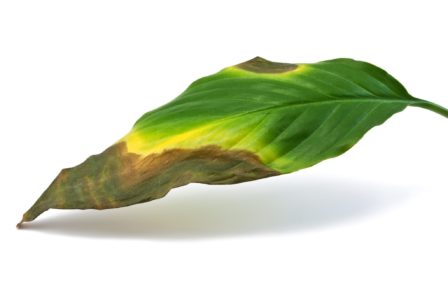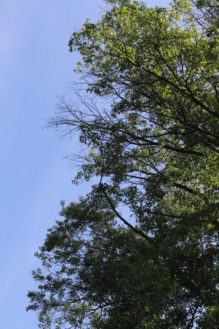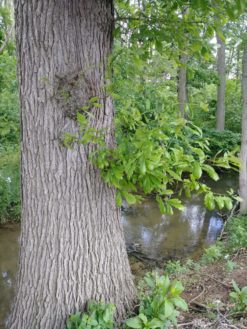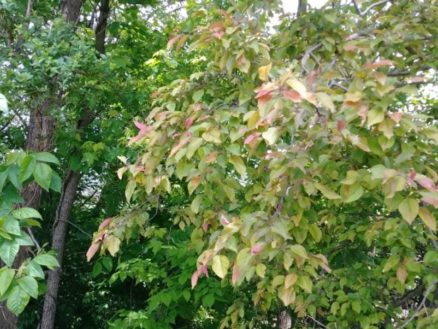“Is my tree dying?”
Many of us can relate: there’s that one tree on our property that is our favorite. It might provide tons of shade for the back patio in the summer time. Perhaps it flowers really beautifully in the spring. Maybe it was planted in memory of someone dear to you. Whatever the reason, many of us are really attached to our trees.
And this is when the panicked calls start. We get them on a regular basis: “I think my tree is really sick. Can you help with that?” The honest answer to this question (which no one really wants to hear) is “Maybe.” Depending on the severity of the issue or the amount of irreversible damage, as professionals, we may or may not be able to do anything about it. There are lots of factors in play that we have no control over. For example, the presence of certain fungi, the amount of humidity and rainfall, and the actual location of a tree are often outside of our control.
The one factor working in our favor is early detection. This increases the likelihood that your tree service company will be able to make an impact. Here are the Top 5 Warning Signs of a sick tree:
1. Leaf Damage
This is perhaps the easiest place to start for many homeowners. Discoloration, deformity, or extra, abnormal “growths” on leaf tissue can all be signs of a potential problems. These range in size, shape of spots, color of spots, and deformity of leaves or needles. This can vary depending on the tree and the disease you’re looking for. For example, evergreen trees are not susceptible to a disease called anthracnose. Anthracnose only effects deciduous (leaf-dropping) trees, and is actually deadly for certain species (like an American dogwood). Conversely, deciduous trees are not generally affected by bagworms, which prefer to feed on needle-producing evergreen trees.
What to Look For
A good practice to get yourself into is to familiarize yourself with the look of the trees in your landscape. What do they look like in a “normal” year? You might even want to consider doing a Google image search for what healthy leaves look like for that species of tree, so you have a baseline reference. If you know what a healthy example of a leaf should look like, you’ll be able to tell when there’s a lesion or deformity. Lesions, deformity, and discoloration or leaves can be indicative of serious pest or disease problems with your trees, which may lead to some of the other signs we’ll discuss.
 2. Canopy Decline
2. Canopy Decline
This one can be a little harder to nail down. Generally speaking, when a tree has lost about 30% of it’s canopy, it is beyond saving. This is especially true for boring insects, like the Emerald Ash Borer. Your tree needs a certain amount of leaf tissue to properly convert sunlight into the food it needs to survive (called photosynthesis). Without the proper amount of chlorophyll (the chemical in plants that makes them green) exposed to the sun, the tree will begin to struggle to stay healthy.
What to Look For
In order to determine whether a tree’s canopy is in decline, you should again try to get a baseline reference. You should try, as much as possible, to get a view of the whole tree. This may involve walking across the street and standing on the sidewalk in front of your neighbor’s house, or asking a neighbor if you can stand in their yard to get this view. Whatever the case, make sure you can see the whole tree to the best of your ability.
When you start to be able to see through the tree’s leaves pretty easily, that’s a bad sign. Consider taking a picture on your phone when the canopy is full (late Spring would be good) for reference the following year. You want to especially look for decline near the top of the tree; many tree problems will cause the tree to decline at the top first, so this is usually the place you’ll see serious problems pop up.
3. Shoot Growth Lower on Branches or Trunk
Diseases often start in the leaf tissue and then work their way into the stems and branches, so when you see a tree pushing leaf tissue anywhere but the very end of a branch, it’s usually an indication that the tree is under some serious stress.
Here’s a fun fact about trees: they often have a “emergency fund” of nutrients stored up, just in case they need them. They’re pretty industrious that way. You’ve probably seen evidence of this when you see a stump that suddenly starts pushing new branches and leaves up. Why the stump is able to push new growth when it’s been cut all the way down to the ground? Or, for that matter, when it has been cut in such a way that all the leaves are gone? Because it had this energy reserve saved.
But trees don’t just save this nest-egg for when someone tries to cut them down. They’ll tap in to this fund any time they need to convert more sunlight into energy. A pest or disease issue that causes canopy decline will often trigger this “new-growth” strategy from a tree. In a tree that’s stressed by one of these factors, you’ll often seen new leaves popping up from much lower on the branch, or even off the trunk itself. Trees by nature typically push new growth at the end of the branches, where it’s got the best chance of getting maximum exposure to sunlight.
What to Look For
If a tree starts pushing new growth closer to the trunk or off the trunk itself, this is a big “red-flag” that the tree is experiencing a potentially deadly form of stress. Look for new leaves growing near where the branches emerge from the trunk or off the of the trunk itself.
4. Many Dead Branches/Pushing Growth in the Wrong Places
We covered some of this in the last point; when a tree is pushing new growth closer to the trunk than the very end of the branch, that’s a bad sign. When you start to see lots of dead wood near the end of the branches, that’s also a very bad sign.
You will often see this, especially with disease issues on trees. A branch may look dead at the end, but new growth is popping up lower on the branch. Another sign to look for is a “hole” in the canopy; the canopy will look full and healthy, except where you see a branch or two that have been affected by disease and aren’t pushing leaves out. A branch or two not pushing new growth will usually be very visible in a mature tree, as the canopy will have a large gap.
What to Look For
Many times, the tree will tap into the above mentioned “emergency fund” to push new growth as close to the end of the branch as possible. A good way to look for this is to stand near the trunk of the tree and simply look up. If a lot of branches with no growth on them or look dead are visible, it’s probably a sign that it’s been stressed for a period of time.
 5. Early Leaf Color Change or Early Leaf Drop
5. Early Leaf Color Change or Early Leaf Drop
We often select trees to plant or become attached to a tree because of the vibrant, beautiful color it gives us, especially in the fall. You’ll be hard-pressed to find someone who doesn’t have some sense of awe when all the wooded areas around us here in Central Pennsylvania begin to change color. It’s a truly breath-taking sight each autumn!
Tree leaves change color because the trees has decided to move it’s chlorophyll in preparation for winter; it is conserving energy so that it can make it through the winter in a healthy way. There are other chemical changes happening, like the one the seals the place where the leaf attaches to the stem (like a scab covering a wound) so that no infections can harm the tree.
However, when this color change, and the subsequent shedding of leaves, happens much earlier in the season than normal, it’s usually a good indicator that the tree is in trouble. Sometimes, when the issue is severe enough, instead of pushing new growth, the tree will decide instead to “cut losses” and go into an early winter hibernation. Think of it like a “fight or flight” response for a tree; new growth is the “fight” response, while the shedding of leaves and closing up shop early is the “flight” response. Instead of wasting energy trying to produce more energy, the tree decides that it cannot out-produce the loss. So, it tries to minimize the damage by waiting until conditions improve. It decides to “ride it out” until things get better.
What to Look For
When the tree reaches this grim conclusion, it’s in a really bad place. You want to look for leaves that are changing color far too early. Here in Central PA, a tree changing color in July or August is a bad sign. You might even be concerned about leaf drop in late August or September, depending on the species.
Comparing the tree you’re concerned about to other trees is also helpful. Are all the trees in your area changing colors? If so, you might not need to be as worried. If not, your tree might be in dire straits.
Conclusion
Now you’re armed with some helpful tips to determine if your favorite tree is in trouble. You should contact a Certified Arborist to examine your tree and recommend the appropriate treatment, if possible. You should also be prepared to hear the worst, and take the recommendation of the Arborist you’ve selected. That means you may need to have the tree removed.
If you’d like to talk to one of our ISA Certified Arborists about your tree’s health, we’re happy to help. Contact us, and we’ll be in touch with you shortly.
The post Is My Tree Dying? Top 5 Warning Signs appeared first on Tomlinson Bomberger.
from Tomlinson Bomberger https://ift.tt/2xcB8z8
No comments:
Post a Comment